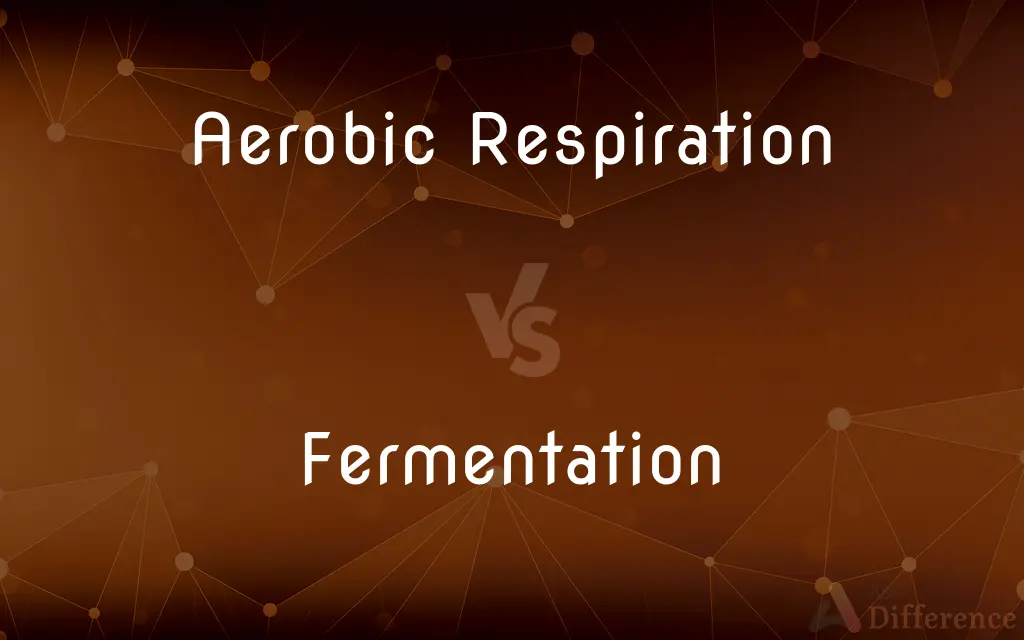Aerobic Respiration vs. Fermentation — What's the Difference?
By Tayyaba Rehman — Published on October 6, 2023
Aerobic Respiration uses oxygen to produce energy from glucose, releasing CO2 and water, while Fermentation occurs without oxygen, producing energy and often alcohol or lactic acid.

Difference Between Aerobic Respiration and Fermentation
Table of Contents
ADVERTISEMENT
Key Differences
Aerobic Respiration is the process cells undertake to convert glucose into energy in the presence of oxygen, whereas Fermentation is an anaerobic process that produces energy without using oxygen.
In Aerobic Respiration, glucose is fully broken down, resulting in a larger amount of energy, carbon dioxide, and water. On the other hand, Fermentation partially breaks down glucose, leading to less energy and by-products like alcohol or lactic acid.
Most multicellular organisms, including humans, rely on Aerobic Respiration for energy. In contrast, Fermentation is common in bacteria, yeast, and muscle cells under low oxygen conditions.
Aerobic Respiration primarily occurs in the mitochondria of cells. Fermentation, however, takes place in the cell's cytoplasm.
Aerobic Respiration is vital for sustained activities and overall cell function. Fermentation is exploited in food and drink production, like in brewing beer or making yogurt.
ADVERTISEMENT
Comparison Chart
Oxygen Requirement
Requires oxygen
Does not require oxygen
By-products
Carbon dioxide and water
Alcohol, lactic acid, or other compounds
Amount of Energy Produced
High (up to 36 ATP molecules per glucose)
Low (2 ATP molecules per glucose)
Location in Cell
Mitochondria
Cytoplasm
Typical Organisms
Most multicellular organisms
Bacteria, yeast, muscle cells in low oxygen
Compare with Definitions
Aerobic Respiration
Converts glucose to ATP in the presence of oxygen.
Aerobic Respiration is a vital process for multicellular organisms.
Fermentation
Converts sugars to energy, alcohol, or acids.
Beer brewing relies on the Fermentation of sugars into alcohol.
Aerobic Respiration
Occurs mainly in the mitochondria.
The mitochondria are often called the powerhouses due to their role in Aerobic Respiration.
Fermentation
Commonly occurs in bacteria, yeast, and certain muscle cells.
When muscles lack oxygen, they resort to Fermentation for energy.
Aerobic Respiration
A cellular process using oxygen to produce energy.
During exercise, our cells increase Aerobic Respiration to meet energy demands.
Fermentation
An anaerobic process producing energy without oxygen.
Yeast performs Fermentation, leading to bread rising.
Aerobic Respiration
Produces carbon dioxide and water as by-products.
Plants intake the CO2 released from Aerobic Respiration for photosynthesis.
Fermentation
Takes place in the cell's cytoplasm.
Unlike other processes, Fermentation doesn't utilize the mitochondria.
Aerobic Respiration
Supports sustained activities and overall cell functions.
To support her marathon running, her cells relied heavily on Aerobic Respiration.
Fermentation
Any of a group of chemical reactions induced by microorganisms or enzymes that split complex organic compounds into relatively simple substances, especially the anaerobic conversion of sugar to carbon dioxide and alcohol by yeast.
Fermentation
Unrest; agitation.
Fermentation
(biochemistry) Any of many anaerobic biochemical reactions in which an enzyme (or several enzymes produced by a microorganism) catalyses the conversion of one substance into another; especially the conversion (using yeast) of sugars to alcohol or acetic acid with the evolution of carbon dioxide
Fermentation
A state of agitation or excitement; a ferment.
Fermentation
The process of undergoing an effervescent change, as by the action of yeast;
Fermentation
A state of agitation or excitement, as of the intellect or the feelings.
It puts the soul to fermentation and activity.
A univesal fermentation of human thought and faith.
Fermentation
A process in which an agent causes an organic substance to break down into simpler substances; especially, the anaerobic breakdown of sugar into alcohol
Fermentation
A state of agitation or turbulent change or development;
The political ferment produced a new leadership
Social unrest
Fermentation
A chemical phenomenon in which an organic molecule splits into simpler substances
Fermentation
Used in various food and beverage production processes.
The tangy taste in yogurt is due to the lactic acid produced during Fermentation.
Common Curiosities
Where does Aerobic Respiration occur in the cell?
Aerobic Respiration primarily happens in the mitochondria.
What is Aerobic Respiration?
Aerobic Respiration is a cellular process converting glucose to energy using oxygen.
Is bread-making an example of Fermentation?
Yes, yeast in bread dough undergoes Fermentation, producing CO2, which makes the bread rise.
How does Fermentation differ from Aerobic Respiration?
Fermentation is an anaerobic process producing energy without oxygen, often yielding alcohol or lactic acid.
Why do our muscles ache after intense exercise?
This can result from lactic acid buildup, a by-product of Fermentation when muscles don't receive enough oxygen.
Which produces more energy, Aerobic Respiration or Fermentation?
Aerobic Respiration produces more energy compared to Fermentation.
Is Aerobic Respiration only found in animals?
No, Aerobic Respiration occurs in most multicellular organisms, including plants.
Is oxygen essential for Fermentation?
No, Fermentation is anaerobic and doesn't require oxygen.
Can humans undergo Fermentation?
Yes, human muscle cells can resort to Fermentation under low oxygen conditions, producing lactic acid.
Why do brewers use Fermentation?
Brewers use Fermentation to convert sugars into alcohol in beverages like beer.
What are the main by-products of Fermentation?
Common by-products include alcohol, lactic acid, or other organic acids.
How do plants benefit from Aerobic Respiration?
Plants use the carbon dioxide produced from Aerobic Respiration for photosynthesis.
Can Aerobic Respiration occur without mitochondria?
No, the primary site for Aerobic Respiration is the mitochondria in cells.
Is yogurt a product of Fermentation?
Yes, the production of yogurt involves bacterial Fermentation, converting sugars to lactic acid.
Which process is faster, Aerobic Respiration or Fermentation?
While Fermentation can produce energy quickly, Aerobic Respiration provides a more sustained energy release.
Share Your Discovery

Previous Comparison
Considerate vs. Sympathetic
Next Comparison
American Football vs. RugbyAuthor Spotlight
Written by
Tayyaba RehmanTayyaba Rehman is a distinguished writer, currently serving as a primary contributor to askdifference.com. As a researcher in semantics and etymology, Tayyaba's passion for the complexity of languages and their distinctions has found a perfect home on the platform. Tayyaba delves into the intricacies of language, distinguishing between commonly confused words and phrases, thereby providing clarity for readers worldwide.
















































